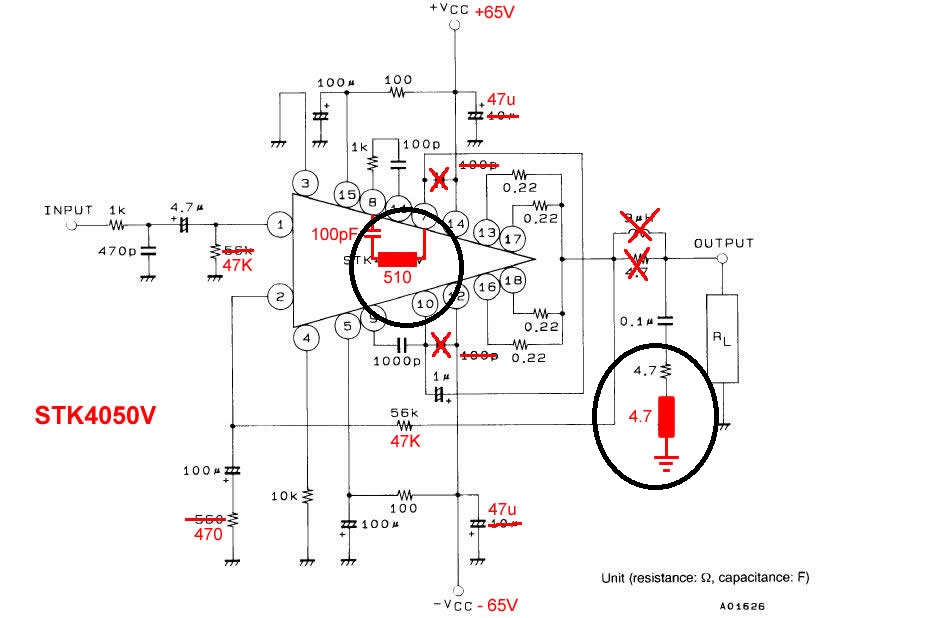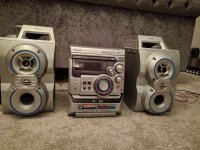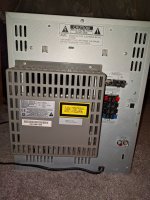Hello,
I have few questions about STK4050 amplifier.
1. Does STK4050 gives 200w @ 8ohms. Is this RMS?
2. What are the differences between STK4050V and STK4050II? Is pin geometry the same? I`m asking this so I can make the blueprint in EAGLE to design PCB.
3.Do any of you have STK4050 library file for EAGLE?
4.How can I tell if STK4050 is original or copy? I will buy from e-bay.
5.What rating transformer do I need for running 2 STK4050? On one site I found 2 x 48v and at least 500VA so at least 1000VA for 2 STKs?
Thank you for help
I have few questions about STK4050 amplifier.
1. Does STK4050 gives 200w @ 8ohms. Is this RMS?
2. What are the differences between STK4050V and STK4050II? Is pin geometry the same? I`m asking this so I can make the blueprint in EAGLE to design PCB.
3.Do any of you have STK4050 library file for EAGLE?
4.How can I tell if STK4050 is original or copy? I will buy from e-bay.
5.What rating transformer do I need for running 2 STK4050? On one site I found 2 x 48v and at least 500VA so at least 1000VA for 2 STKs?
Thank you for help
Do not buy!!!Hello,
I have few questions about STK4050 amplifier.
1. Does STK4050 gives 200w @ 8ohms. Is this RMS?
2. What are the differences between STK4050V and STK4050II? Is pin geometry the same? I`m asking this so I can make the blueprint in EAGLE to design PCB.
3.Do any of you have STK4050 library file for EAGLE?
4.How can I tell if STK4050 is original or copy? I will buy from e-bay.
5.What rating transformer do I need for running 2 STK4050? On one site I found 2 x 48v and at least 500VA so at least 1000VA for 2 STKs?
Thank you for help
Today ALL are fake!
STK4044
If you choose the 100W STK Sanyo version, then there are still some genuine parts on Ebay. I have tested the STK4044 recently. Performance even better then stated in the datasheet.
http://www.diyaudio.com/forums/chip-amps/228860-stk4044-power-2.html#post5254459
If you choose the 100W STK Sanyo version, then there are still some genuine parts on Ebay. I have tested the STK4044 recently. Performance even better then stated in the datasheet.
http://www.diyaudio.com/forums/chip-amps/228860-stk4044-power-2.html#post5254459
Do not buy!!!
Today ALL are fake!
Wow.
That's so bad.
I will try to found used one than, do you think that fakes are realy that bad?
If you choose the 100W STK Sanyo version, then there are still some genuine parts on Ebay. I have tested the STK4044 recently. Performance even better then stated in the datasheet.
http://www.diyaudio.com/forums/chip-amps/228860-stk4044-power-2.html#post5254459
I could, but I want more power
better to aim for some solid state amplifier with transistors in output, my opinion. many amplifiers can achieve wanted results here.
Hello,
I found Sharp Sc-8800 (it has 2x STK4050) that somebody is selling near me for 160EUR. So I`m buying that one. It`s an old unit, but I will repleace all capacitors and some other parts if necessary. The seller wrote that it sounds good.
At the cost of all the components I`m better of buying this Sharp.
However I already ordered parts for my STK442-090 build. I was ready to build something so I will 🙂 I have original STK442-090, heatsink and transformer for it.
I will use arduino for VU meter and for volume control (I have leftover potentiometer mounted to servo, so I can also use remote controller to adjust the voltage).
I measured transormer and it`s 31-0-31, if I multiply 31v by 1,4 i get 43,4vdc.
However this is without load, what voltage drop can I expect? Transformer is 150VA.
STK422-090 max voltage suply is +-47 with 6 or 8ohm load, but all the measurements for the datasheet were measured at +-35v. Is it safe to run it with this transformer?
I found Sharp Sc-8800 (it has 2x STK4050) that somebody is selling near me for 160EUR. So I`m buying that one. It`s an old unit, but I will repleace all capacitors and some other parts if necessary. The seller wrote that it sounds good.
At the cost of all the components I`m better of buying this Sharp.
However I already ordered parts for my STK442-090 build. I was ready to build something so I will 🙂 I have original STK442-090, heatsink and transformer for it.
I will use arduino for VU meter and for volume control (I have leftover potentiometer mounted to servo, so I can also use remote controller to adjust the voltage).
I measured transormer and it`s 31-0-31, if I multiply 31v by 1,4 i get 43,4vdc.
However this is without load, what voltage drop can I expect? Transformer is 150VA.
STK422-090 max voltage suply is +-47 with 6 or 8ohm load, but all the measurements for the datasheet were measured at +-35v. Is it safe to run it with this transformer?
What the numbers are telling you is that the amplifier is OK with up to +/-47V rails if used on nominal 8 ohm speaker loads. I doubt it would cope with 6 ohm loads for long in typical amplifier builds. If you use 4 ohm speakers (or parallel 8 ohm speakers) you will need to reduce the supply voltage, probably to the rated +/- 35V or below, to keep the module's dissipation within safe limits. This assumes a specified or recommended amount of heatsinking and ventilation, which is equally important to power ratings.
A 150VA transformer will not be enough for a 100W RMS continuous power rating stereo amplifier though. If you are serious about that 100W power rating, I would not be messing with hybrid modules or small transformers in any case.
Hybrid audio power modules are long obsolete and the types you can still buy are mostly cheaply assembled, after-market replacement types or refurbs and these are all "fakes" in comparison to Sanyo's original parts. As Piersma mentioned though, there are a few replacement types that are of comparable quality but how can you be certain of this if you buy from unknown sellers on the internet? In some applications that are not subject to heavy use or abuse, some of these products have indeed proved to work ok - just don't expect many of them to meet the original specs or perform like the original products.
The voltage drop of any transformer depends on type and size. A 150VA toroidal transformer will typically have a regulation of about 8% drop between zero and full rated load. A conventional E-I transformer will vary much more, depending on the specific design and materials quality. Using a smaller transformer with poor regulation, to limit the power output to heavy loads, is not a bad idea and this was often done by manufacturers as a safety measure and for cost reduction. The design of such an amplifier that does not also sound compressed and weak in normal use though, is not so simple.
A 150VA transformer will not be enough for a 100W RMS continuous power rating stereo amplifier though. If you are serious about that 100W power rating, I would not be messing with hybrid modules or small transformers in any case.
Hybrid audio power modules are long obsolete and the types you can still buy are mostly cheaply assembled, after-market replacement types or refurbs and these are all "fakes" in comparison to Sanyo's original parts. As Piersma mentioned though, there are a few replacement types that are of comparable quality but how can you be certain of this if you buy from unknown sellers on the internet? In some applications that are not subject to heavy use or abuse, some of these products have indeed proved to work ok - just don't expect many of them to meet the original specs or perform like the original products.
The voltage drop of any transformer depends on type and size. A 150VA toroidal transformer will typically have a regulation of about 8% drop between zero and full rated load. A conventional E-I transformer will vary much more, depending on the specific design and materials quality. Using a smaller transformer with poor regulation, to limit the power output to heavy loads, is not a bad idea and this was often done by manufacturers as a safety measure and for cost reduction. The design of such an amplifier that does not also sound compressed and weak in normal use though, is not so simple.
Hello,What the numbers are telling you is that the amplifier is OK with up to +/-47V rails if used on nominal 8 ohm speaker loads. I doubt it would cope with 6 ohm loads for long in typical amplifier builds. If you use 4 ohm speakers (or parallel 8 ohm speakers) you will need to reduce the supply voltage, probably to the rated +/- 35V or below, to keep the module's dissipation within safe limits. This assumes a specified or recommended amount of heatsinking and ventilation, which is equally important to power ratings.
A 150VA transformer will not be enough for a 100W RMS continuous power rating stereo amplifier though. If you are serious about that 100W power rating, I would not be messing with hybrid modules or small transformers in any case.
Hybrid audio power modules are long obsolete and the types you can still buy are mostly cheaply assembled, after-market replacement types or refurbs and these are all "fakes" in comparison to Sanyo's original parts. As Piersma mentioned though, there are a few replacement types that are of comparable quality but how can you be certain of this if you buy from unknown sellers on the internet? In some applications that are not subject to heavy use or abuse, some of these products have indeed proved to work ok - just don't expect many of them to meet the original specs or perform like the original products.
The voltage drop of any transformer depends on type and size. A 150VA toroidal transformer will typically have a regulation of about 8% drop between zero and full rated load. A conventional E-I transformer will vary much more, depending on the specific design and materials quality. Using a smaller transformer with poor regulation, to limit the power output to heavy loads, is not a bad idea and this was often done by manufacturers as a safety measure and for cost reduction. The design of such an amplifier that does not also sound compressed and weak in normal use though, is not so simple.
I have transformer and original samsung wb-650. Samsung was playing nice until it did... (mobo problem) so I think it should do it. I`m not sure about transformer because it has no rating on it but on the back of samsung was writen 150w...
... original samsung wb-650. ...on the back of samsung was writen 150w...
Is it this product?
I know the series. The "150W" is the total input power, before amplifier losses, and including the snazzy CD round-about. The actual audio power output was more like 40 Watts in the main channels, and into an odd impedance load.
And our experience was that these units would overheat and shut-down in heavy use. We had to retire them from classroom use.
If you are trying to salvage the transformer and heat sinks, you need to figure out just what DC voltages are on the main power supply. Then we can back-think to what chips can work and what power can be made.
Attachments
Last edited:
Hello, i have stk 442-090 from it and I already ordered all the parts for it.Is it this product?
I know the series. The "150W" is the total input power, before amplifier losses, and including the snazzy CD round-about. The actual audio power output was more like 40 Watts in the main channels, and into an odd impedance load.
And our experience was that these units would overheat and shut-down in heavy use. We had to retire them from classroom use.
If you are trying to salvage the transformer and heat sinks, you need to figure out just what DC voltages are on the main power supply. Then we can back-think to what chips can work and what power can be made.
Stk442-090 was not for main channels, but for subwoofers. Main channel used alot smaller stk that I trow away because it was defective and I can't remember the exact model.
I also have 200va transformer that will output 32vdc so I will use that one if original won't be strong enought and I think that overhitting shouldnt be the problem because in the samsung there were 2 stks on one heatsink and now it will be only one. If not I will upgrade heatsink or install the fan.
Yes this is the product.Is it this product?
I know the series. The "150W" is the total input power, before amplifier losses, and including the snazzy CD round-about. The actual audio power output was more like 40 Watts in the main channels, and into an odd impedance load.
And our experience was that these units would overheat and shut-down in heavy use. We had to retire them from classroom use.
If you are trying to salvage the transformer and heat sinks, you need to figure out just what DC voltages are on the main power supply. Then we can back-think to what chips can work and what power can be made.
I had 250rms 4ohm car sub connected to it blasting at max for some time and there were no problems.
Coincidentally i was looking for this stk4050 .Nowdays im quite sure if the seller is from China , the parts are certainly fake.I have bought countless power devices from the better Chinese suppliers and it always end up as physically looking good fakes.
Has anyone tried the STK4050 by them? Its even more dubious these will ever work at +_65V supply rails outputting 200watts in Class AB.
I do have my 90s genuine collection of STK412-170 rated at 180w min x 2 in class H which is still in analog domain.
These are proven power devices up to 300w x 2 DIN power as measured by some audio makers in their specs.
tell me if are interested to try these.
Has anyone tried the STK4050 by them? Its even more dubious these will ever work at +_65V supply rails outputting 200watts in Class AB.
I do have my 90s genuine collection of STK412-170 rated at 180w min x 2 in class H which is still in analog domain.
These are proven power devices up to 300w x 2 DIN power as measured by some audio makers in their specs.
tell me if are interested to try these.

hi guys, in relation to stk4050 I saw this scheme with modification to limit the oscillation of the IC. Didn't understand if the 4.7 is a resistor or capacitor? while the 510 should be a resistance right?
- Status
- Not open for further replies.
- Home
- Amplifiers
- Solid State
- STK4050

